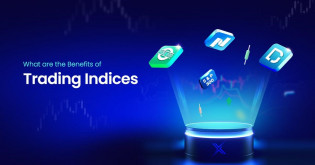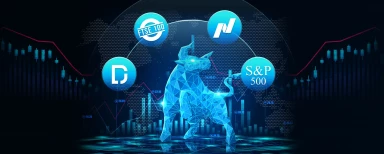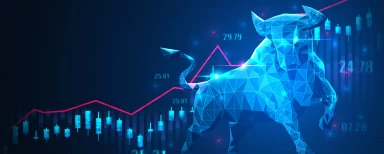-
In the Spotlight of 2023, Contract for Difference (CFD) trading is extremely popular. Its derivative trading that lets investors speculate on the growing or decreasing values of numerous financial assets, including stocks, commodities, currencies, and indices. When you engage in contract for difference (CFD) trading, you do not really purchase the underlying asset; rather, you trade a contract that represents the movement of the asset's price. This type of trading is known as a "contract for difference" (CFD).
What is CFD Trading?
Contract for difference trading, or CFD trading, is a popular way to speculate on the price movements of stocks, indices, currencies, and commodities without having the real commodity. Instead, traders buy or sell contracts that show how the actual product's price changes.
To understand CFD trading better, let's take an example of buying a CFD on XYZ stock. Suppose the XYZ stock is trading at a sell/buy price of $50/$51, and you believe that the stock's price will go up. You decide to buy 100 CFD units of XYZ stock at a buy price of $51 per unit.
Outcome A: A Profitable Trade Your prediction was correct, and the price of XYZ stock goes up to a sell/buy price of $60/$61. You decide to close your position by selling at the new sell price of $60. Multiply this by the size of your position (100 units) to calculate your gross profit, which is $900. The price has moved 9 points (60 - 51) in your favour.
Outcome B: A Losing Trade Unfortunately, your prediction was wrong, and the price of XYZ stock goes down to a sell/buy price of $40/$41. You decide to close your position by selling at the new sell price of $40 to limit your potential loss. The price has moved 11 points (51 - 40) against you. Multiply this by the size of your position (100 units) to calculate your loss, which is $1,100.
Advantages of CFD Trading
- Speculate in Both Rising and Falling Markets
- Efficient Use of Capital
- Hedging Other Investments
- Flexible Contract Sizes
- Access Global Financial Markets
CFD trading has become increasingly popular in recent years, with search popularity for the term increasing by 137% from 2012 to 2023. This flexible trading method allows traders to speculate on the price movements of financial assets without owning them. Here are some of the advantages of CFD trading:
Speculate in Both Rising and Falling Markets
One of the biggest advantages of CFD trading is that traders can potentially profit in both rising and falling markets. In a rising market, traders can buy a CFD and then sell it later. This is known as "going long." In a falling market, traders can sell a CFD position first and then buy it back later, closing out the position. This is known as "going short."
Efficient Use of Capital
CFDs are leveraged products that enable traders to increase their exposure to an underlying asset with a small initial outlay. When traders open a trade, they only need to deposit a small percentage of the position's value, known as the margin. Leverage can result in added gains should the market move in the trader's favour; however, it also carries risks and can result in increased losses should the position move against them.
Hedging Other Investments
CFDs are a great tool for hedging an existing portfolio. The ability to go long as well as go short with CFDs means that they are a cost-effective alternative to selling the portfolio prematurely and can be used to provide insurance against adverse price movements. For example, if a trader has a long-term portfolio, they wish to keep it. However, they believe there is some short-term risk to the portfolio's value, so they could use CFDs to hedge their positions. If the portfolio's value falls, the profit made on the CFDs will offset the losses in the portfolio.
Flexible Contract Sizes
Flexible sizing allows traders to tailor their trading according to risk management criteria. The contract sizes of CFDs are usally less than the typical contract size of the underlying instrument. This means traders can gain exposure to the instrument's price movement without a significant deposit.
Access Global Financial Markets
CFDs allow traders and investors access to a wide array of global markets that would otherwise be difficult to access. CFDs make it easy in terms of trading commodities such as Gold, Silver, and Oil, as well as various global indices, without having to trade the futures contract itself.
[ Suggest read : best indices to trade ]
CFD Trading Risks and Risk Management
- Develop a Trading Plan and follow it.
- Start Slowly and Build Your Skills and Expertise
- Understand the Markets You Want to Trade On
- Monitor Your Open Positions
- Use Stops and Limits to Protect Against Sudden Market Movements
- Keep Learning
While CFD trading offers several advantages, it also involves a high level of risk(as indicated by the caution disclaimer), and traders must carefully consider the potential risks involved before making any trades. Over four in ten (45%) of self-directed investors, particularly those investing in high-risk, high-return types, tend not to view losing some money as a potential risk of investing. Here are some risk management strategies that traders can use to control their risk exposure:
Develop a Trading Plan and follow it
Developing a trading plan can help traders clearly define and achieve their overall financial trading goals. A trading plan should include risk management strategies, entry and exit points, and clear guidelines for when to open and close positions. Traders should adhere to their trading plan and avoid making impulsive decisions based on emotions.
Start Slowly and Build Your Skills and Expertise
If traders are new to leveraged products, they can get used to how leverage works by trading in small sizes while they develop their understanding. With an introduction program, new clients can trade at reduced minimum trade sizes for two weeks and reduced commissions for six weeks.
Understand the Markets You Want to Trade On
Traders should ensure they understand the factors that influence different markets so they can base their trading strategies on the most relevant information. Our Forex academy section covers each market we offer in great depth. Our experts provide regular data and commentaries on news and trade ideas.
Monitor Your Open Positions
Traders should ideally be able to constantly monitor their open positions and react to market movements. Practically, however, this is often difficult. Our platform is available via our free app, so traders can monitor trades on their mobile or tablet. Traders can also set up price alerts to notify them when specific prices are reached.
Use Stops and Limits to Protect Against Sudden Market Movements
Sudden market movements can cost traders if they aren't able to react immediately or if the market gaps moving sharply up or down with no trading in between. Risk management tools where you can set the limits of your bets can help to protect traders from sudden market movements and gaps and to lock in profits when the market moves in their favour. These tools are stop losses, guaranteed stops, trailing stops, and limit orders.
Keep Learning
The best way for traders to enhance their odds of making money is to broaden their knowledge of the markets they participate in and experiment with different trading tactics.
Developing a Successful CFD Trading Strategies and Tips
- Read more about CFD Before you start trading
- Make up a trading strategy
- Follow your CFD trading strategy
- Analyze the markets to determine the best time to trade
- Understand your total position size
- Choose a reputable and reliable CFD broker
- Set stop-loss orders
- Start out small
- Monitor your open positions
- Keep a trading journal
Developing a well-defined trading strategy is crucial to your success in CFD trading. By following a structured approach, you can make more informed decisions and avoid impulsive actions. Here are some essential tips for successful CFD trading strategies:
- Read more about CFD Before you start trading: CFDs, it is important to have a basic understanding of the market and its terminology. You should learn about trading terms, tools, and risk management strategies. Once you grasp the theory, practice on a demo account to gain experience and intuition in the market.
- Make up a trading strategy: A well-defined strategy is crucial to your success in CFD trading. Your strategy should determine what assets to trade, how long to hold positions, what tools to use, and what entry and exit criteria to follow. Before applying your trading strategy to real trades, develop and test your trading strategy on a demo account.
- Follow your CFD trading strategy: Once you have a strategy in place, it is important to follow it consistently. This means adhering to your entry and exit criteria, risk management techniques, and overall trading objectives. Avoid impulsive actions and remain calm and cool-headed.
- Analyze the markets to determine the best time to trade: Each asset has its own best time to trade based on liquidity, volatility, and market conditions. Understanding the market and analyzing price trends can help you identify the optimal time to enter and exit trades.
- Understand your total position size: Proper risk management is key to successful CFD trading. A well-defined risk management plan will help you avoid unnecessary losses and maximize profits. Monitor the total volume of all your open positions, the amount of funds necessary to hold positions open on the trading platform, and be careful with leverage.
- Choose a reputable and reliable CFD broker: It is essential for a successful trading experience. Consider factors such as regulation and security, trading platform features, fees and spreads, and customer support when selecting a broker.
- Set stop-loss orders: The market can be unpredictable, so it's important to set stop-loss orders to limit your potential losses. This will help automatically close a trade at a specified level should the market move against you.
- Start out small: Don't aim to make a large profit immediately. Even a small but stable income is a step forward and can motivate you to continue trading. Start with a small investment and focus on gaining experience and understanding the market.
- Monitor your open positions: Identifying and reacting to market movements is crucial. While it's unnecessary to constantly watch the market, it's important to check in regularly and make informed decisions based on price trends and news events.
- Keep a trading journal: It can help you identify patterns in your trading, assess your strategy's effectiveness, and refine your approach to maximize profitability. Record your trades and analyze your performance over time to make informed decisions and continuously improve your trading strategy.
Final Thoughts
CFD trading offers numerous advantages for traders, such as low trading costs, leverage, and the ability to profit from both rising and falling markets. However, it's essential to develop a solid trading strategy, implement effective risk management techniques, and choose a reputable broker to maximize your chances of success. By following the guidelines outlined in this comprehensive guide, you can embark on a rewarding journey into the world of CFD trading.




